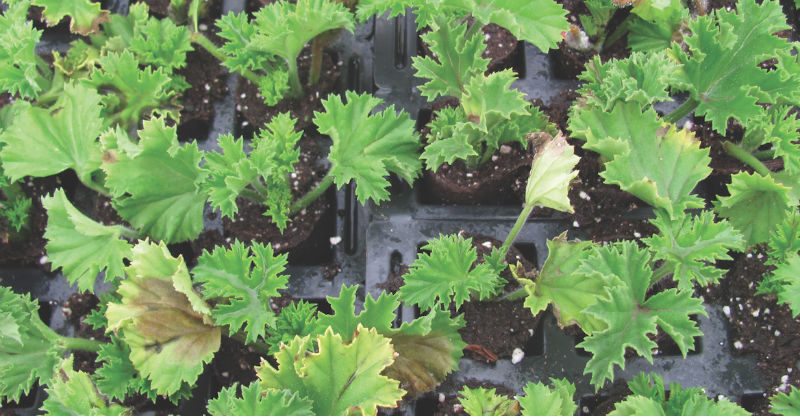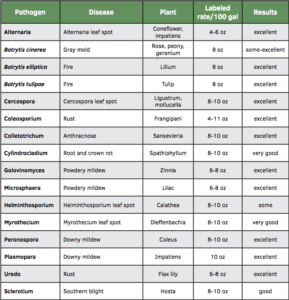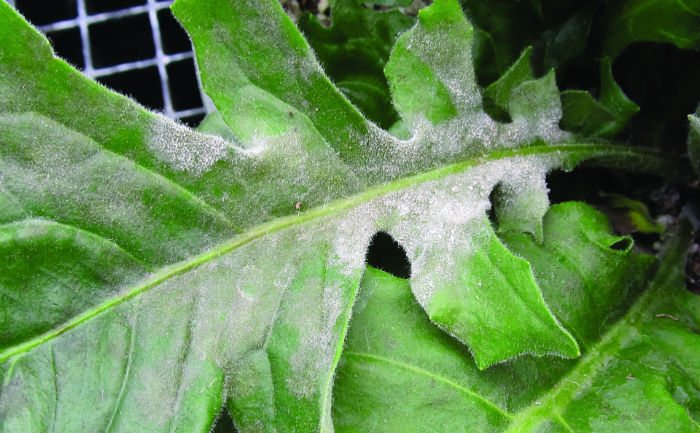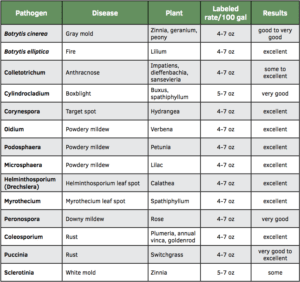
New Options for Battling Plant Diseases
The introduction of new fungicides is always welcome and when the products are in a new FRAC group or have other new features this is especially celebrated — at least by plant pathologists. Two of the newest products are Mural (Syngenta) which was introduced early in 2016 and Orkestra (BASF) which will debut in mid-2016. Each product represents a combination of a FRAC 11 strobilurin with a FRAC 7 SDHI. Mural is azoxystrobin plus the newly available benzovindiflupyr, and Orkestra is pyraclostrobin and another new SDHI — fluxapyroxad.
Aaron is very active doing trials on ornamental crops along with other researchers throughout the United States. Since I closed our greenhouse/laboratory facility in 2012, I have not been involved in doing any testing myself. But that does not stop me from being interested in more things than ever and ferreting out information published by these other researchers.
Orkestra
We were able to locate trials shown in Table 1 to understand the efficacy of Orkestra on ornamental diseases. I also did a review of published trials on agronomic crops that showed the following additional results for those diseases that occur on ornamentals as well: Cladosporium (very good to excellent), Corynespora (good), Phomopsis (very good to excellent), Gymnosporangium (cedar apple rust, very good to excellent), Sclerotinia (good to very good) and Septoria (good to excellent). Orkestra is clearly very broad spectrum in what it can control at a very high level of efficacy.

Orkestra has a 12-hour REI and bears the signal word: “Warning.” The product combines fluxapyroxad and pyraclostrobin in a 1:1 ratio for a 43 percent active product. Fluxapyroxad is adsorbed to the waxy cuticle and moves translaminarly thus protecting both the upper and under leaf surfaces. It also moves in the xylem and has some curative action depending on the pathogen and host crop. Orkestra is labeled for greenhouse, lathhouse and shade house use as a foliar spray or drench and can be applied through chemigation. It is also labeled for outdoor container and field- grown crops, including forest and conifer nurseries and can be applied aerially in these instances. Finally, the product is registered for use in retail nurseries and in residential and commercial landscapes.
Foliar spray interval is usually seven to 14 days with drench intervals of seven to 28 days. Some crops are listed as tolerant, but you should always test new products on your crops under your growing conditions before broad scale use. Crops listed as sensitive were: impatiens, petunia, dianthus and viola. Drenches have occasionally shown stunting on impatiens and petunia. Foliar sprays have occasionally caused discoloration in petunia and impatiens flowers. Do not apply to Physocarpus (ninebark) or wintercreeper (Euonymus fortunei) as these crops are well documented to be sensitive to pyraclostrobin. The product is also labeled in a limited way for juvenile fruit and nut trees, vine, brambles and bushberries produced in ornamental nurseries.

Mural
Mural is a broad-spectrum fungicide for use in greenhouses, shade-houses, lath houses, outdoor nurseries, retail nurseries and commercial landscapes. It is also registered for use in vegetable transplants that are grown for resale to consumers. It has a 12-hour REI and the signal word: “Caution.” The product combines azoxystrobin and benzovindiflupr in a 2:1 ratio for a 45 percent active product. Mural has application directions for chemigation as well as most other ground application methods. It can also be applied through aerial means.
Results with Mural on ornamental diseases have generally been very good to excellent. For most foliar uses, the application interval is seven to 21 days. Plant safety with Mural is good but there are a few plants you should not apply it to. These include apple (Malus), and crabapple (some varieties), leatherleaf fern and Ligustrum. As with previous products containing azoxystrobin, this is the part of Mural that can be phytotoxic to these crops.

One Final Note
Alternating these two new products might seem like a great idea. But the best reason to alternate or rotate is to prevent rapid development of fungicide resistance. Since each product is a combination of a FRAC 11 and a FRAC 7 fungicide, this strategy won’t work. You need to alternate to another FRAC group fungicide to achieve the resistance management results you require.


 Video Library
Video Library 




















